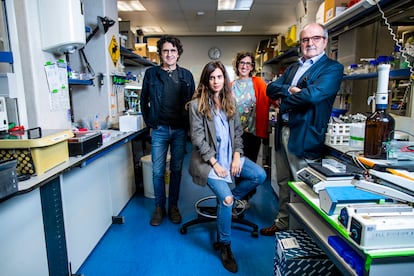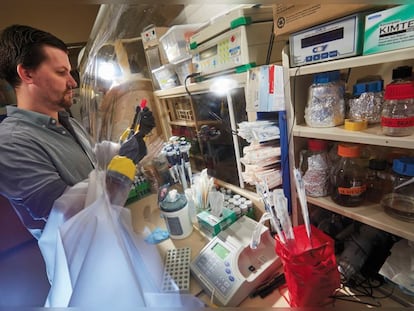Unique case of woman who survived 12 tumors may indicate ‘new disease’
Doctors and scientists have identified a never-before-seen mutation that multiplies the appearance of cancer cells and could lead to ‘immediate clinical applications’

A Spanish woman who overcame 12 tumors, five of them malignant, before the age of 40 is providing new hope for cancer research. Doctors and scientists who treated the patient cannot explain how she is still alive. The unique case may help improve early diagnosis and lead to the development of new cancer treatments.
Dr Miguel Urioste remembers the first time he met the patient, who is now 36 years old and whose identity has not been revealed to protect her privacy. The year was 2015. The patient had already undergone five cancer treatments for tumors in various organs and surgeries to remove other non-cancerous malformations. No one up to that point had tried to connect the dots to explain what lay behind such a high cancer rate.
The woman was small in stature, suffered from microcephaly (when a baby’s head is smaller than expected) and had marks on her skin. But intellectually, she was in perfect condition, recalls Urioste, who was the head of the Family Cancer Unit at Spain’s Cancer Research Center (CNIO) until he retired in January. “We traced her family tree and everything seemed in order; parents and sisters had no problems; it [her case] did not fit with any known clinical picture,” he says.
The researchers analyzed several of the patient’s genes in search of common mutations that increase the risk of tumors. None showed defects. So they began to search using a technology only available in leading molecular biology research laboratories: single-cell sequencing. This system makes it possible to extract thousands of cells from the blood of the patient and their relatives and read the complete genome of each of them.
The results of the investigation, published on Wednesday in Science Advances, reveal that the unique case was due to a genetic mutation that had never before been observed in humans. The woman had inherited from each of her parents a mutated copy of the MAD1L1 gene. The few scientific references on the mutations of this gene came from studies with mice: if the animal had it, it never survived birth. “It was very difficult to understand how this woman could survive with this mutation; There had to be something else that had helped her,” explains Marcos Malumbres, head of the Cell Division and Cancer group at CNIO, who participated in the genetic studies of the patient and her family.
After a sperm fertilizes an egg and an embryo is formed, each cell carries within it the instructions to grow, multiply, transform into neurons, heart or bone and give rise to a healthy baby. Those instructions are the genome: a book containing three billion letters of DNA structured in 46 chapters called chromosomes. This patient’s doubly mutated gene caused cell growth to go haywire. Some cells inherited far more chromosomes than they should, and others far fewer. The body’s own safety mechanisms should have caused a miscarriage, but they didn’t.
The key to this woman’s survival seems to lie in her own illness. Up to 40% of her blood cells have too many or too few chromosomes, a type of defect known as genomic instability, which is a hallmark of cancer. The patient’s immune system had reacted to this threat with widespread inflammation. Her defenses were on continuous red alert. The mutation meant she suffered from cancer much more frequently, but her immune system was also highly stimulated, which favored better identification and destruction of tumor cells, explains CNIO biochemist Carolina Villarroya, the lead author of the study. “Her genetic defect ended up protecting her. She healed very well from all malignant tumors after surgery and treatments; partly thanks to her immune system,” she explains. The woman’s tumors also had high genomic instability, which is “a weak point” for their survival, adds the scientist.
The patient has not developed any tumors since 2014. She lives alone, has a job and leads a normal life despite having to be closely monitored by doctors. “I spoke with her a few days ago, and she is fantastic,” says Urioste.
For now, the team has not named a new disease for the patient, as there is only one known case so far. Instead, the researchers have included it in a group of rare genetic disorders known as mosaic variegated aneuploidy (MVA) syndrome. Up until now, only three genes were known to cause MVA. People who suffer from the syndrome have a higher risk of cancer and may develop one or two tumors throughout their lives. But the fourth gene responsible for MVA, the mutation in MAD1L1, triggers more cancer than the others, says Urioste. “This is also the patient who has survived this kind of disease the longest, because most usually die in childhood,” he says.
The researchers believe that the extraordinary case will help improve cancer diagnosis and develop new treatments. One of the most outstanding results is that researchers have managed to detect small colonies of cells that have chromosomal defects characteristic of leukemia. It may be a pre-cancer, or not. This is the potential of single cell sequencing, says Malumbres. “I believe that this technology should be in hospitals within 10 years.” But he adds that he would not like to be in the shoes of doctors who detect this type of genetic defect in a patient and cannot apply any treatment, as there is still no cancer.
For Urioste, it is obvious what these doctors should do: monitor the patient more closely to detect cancer earlier than current methods allow, which would increase the chances of survival. Urioste says that “it is not uncommon” for a case of hereditary cancer to go undetected.
For his part, Villarroya points out that the study of the patient may reveal new ways of stimulating the immune system of patients so that it detects and eliminates tumors – the basic mechanism of cancer immunotherapy treatments.
Ana Beatriz Sánchez Heras, a specialist in familial and hereditary cancer from the Spanish Society of Medical Oncology, who did not participate in the study, argues the research has very important implications. “It is a work that increases knowledge of the many mechanisms and molecular pathways that favor the malignant transformation of cells. It will undoubtedly have immediate clinical applications in the diagnosis, and possibly in the treatment, of cancers,” she says.
Jair Tenorio, a specialist in rare diseases of genetic origin at Madrid’s La Paz Hospital, who discovered Tenorio syndrome, believes that the patient in the study may be among the people with the highest risk of known tumors in the world. “I think we are facing a new disease,” he says. But the last word, he explains, will be had by the OMIM, the world’s largest database of disorders of genetic origin. Maybe they will decide what to call it.










































